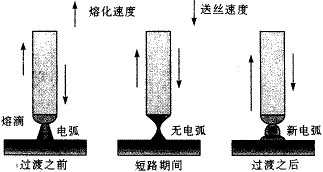Gas shielded welding in the machine tool industry
Summary of the structural parts and weld quality Heavy overall efficiency considerations, the principle of the droplet analysis showed, CO 2 gas shielded arc welding process for solid wires plus compounded by gas (80% Ar + 20% CO 2) was added Solid wire is used instead.
Keywords GMAW applications droplet transfer structure
1 Introduction
Since the early 1980s, with the continuous growth of China's national economy, the machine tool industry has also achieved rapid development, and the production process has gradually been aligned with the international level. Our company took the lead in introducing the technology of all-steel presses of American VERSON in the national machinery industry. The large components of mechanical presses were transferred from the former castings to the welded structural parts, and the welding technology level was also improved accordingly. It was previously wasteful and inefficient. The manual arc welding turned to semi-automatic gas shielded welding with significantly improved efficiency.
Carbon dioxide gas shielded welding has been used in our company for more than ten years, and the welding process is becoming more and more mature, but there are still some problems in the appearance quality of the weld. In the welding production process of similar products, binary or even ternary mixed gas plus solid wire welding (GMAW) or pure carbon dioxide gas plus flux cored wire welding (Flux-Cored) has been widely used in developed countries. Arc Welding referred to as FCAW) instead of carbon dioxide gas plus solid wire welding (GMAW). Choosing the appropriate welding process in the process of continuous improvement of our company's manufacturing level is particularly important for improving the quality of our products. Due to the high price of domestic flux cored wire and mixed gas, the welding production of our company still uses solid wire carbon dioxide gas shielded welding. This article will start from the basic principle of the droplet transfer, combined with the development of our company's welding technology, to explore the future direction of welding technology development.
2 Welding process classification
The welding process can be divided into five modes according to the metal droplets: short-circuit transition mode; particle transition mode; jet transition mode; pulsation transition mode; high-speed jet transition mode. The first three modes of these five modes are more common in China, and this paper will analyze these three modes.
2.1 Short circuit transition mode
During the short-circuit transition, the droplet transition is formed after the wire is in contact with the molten metal bath. The rate at which the wire is melted and the wire feed speed determine the transition of the droplet at an intermittent state. When the wire feeding speed is higher than the melting speed of the wire, the wire contacts the molten pool to form a short circuit state, the current rapidly increases, the heat passing through the wire increases rapidly, and at the same time, the welding wire begins to deform, and the wire ends are formed fine under the action of the electromagnetic force. In the neck, the end of the wire is broken at the end of the wire under the continuous action of current and electromagnetic force, forming a droplet into the molten pool. After the short circuit condition is over, an arc is formed between the wire and the molten pool. This process is repeated 50 to 250 times per second (Figure 1). It can be seen from the above that in the short circuit process, there is no arc between the workpiece and the welding wire, the total heat input is low and the depth of the bath is shallow. When welding thicker plates, careful selection of process parameters is required to ensure that the workpiece is penetrated. On the other hand, due to its low heat input, the molten pool solidifies faster. This form of droplet transfer is ideal for all-position welding and is also suitable for thin-plate welding requiring small deformation.

Figure 1 Schematic diagram of short-circuit transition state
2.2 Particle transition mode
The droplet droplet transition mode is characterized by the molten metal forming a droplet transition through the arc in the form of large particles. This transition is required for welding current and voltage and must be between the current and voltage values ​​of both the short circuit transition and the jet transition. When CO2 is used as the shielding gas, the current is larger than that in the short-circuit transition state, and the size of the droplet is often 2 to 4 times the diameter of the wire. The droplet transfer is not along the axis of the arc, but is deflected upward at the end of the wire due to the influence of the arc force, and finally falls into the molten pool under the gravity of the droplet, or the droplet is too large to form a transition with the molten pool. figure 2).

Figure 2 Schematic diagram of the transition state of droplets
Next page
Gas pressure reducing valve is a valve in the body of the opening of the opening and closing of regulating the flow of medium, the medium pressure is reduced, at the same time with the aid of the role of the valve after pressure adjust the opening of open-close part, keep the valve after pressure within a certain range, and the valve body or valve after the injection of cooling water, reduce the temperature of medium, the valve is called desuperheating valve to relieve stress.The characteristics of gas pressure reducing valve are that in the case of constant changes in inlet pressure, keep the outlet listening pressure and temperature value within a certain range, and this type of valve should be installed horizontally in the pipeline generally.
Propane Regulator,Extremely Stable Performance Regulator,Gas Regulator,Performance Gas Propane Regulato
Ningbo SaiOu Cookware Co., Ltd. , https://www.nbsaioucookware.com